View current page
...more recent posts
"Steamboy" [mp3 removed]
"Dedicated to BK" [mp3 removed]
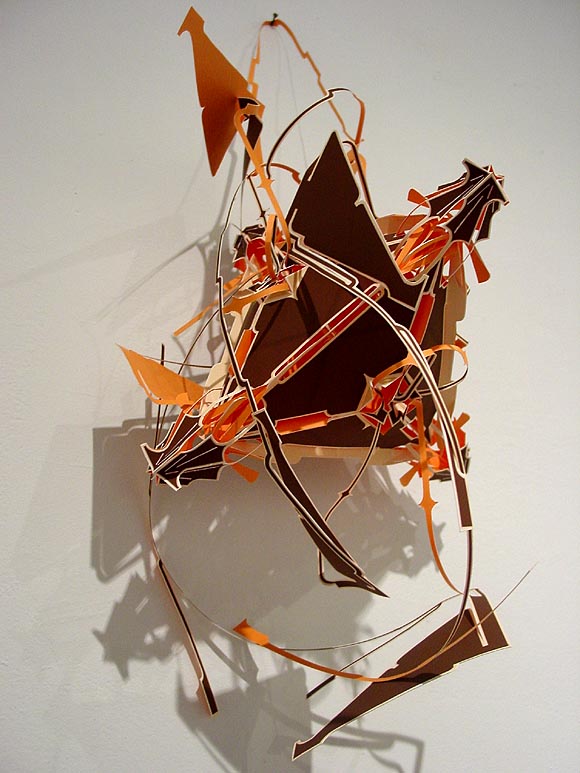
Karl Jensen, Tetrapod #3A, printed paper; Momenta Art benefit
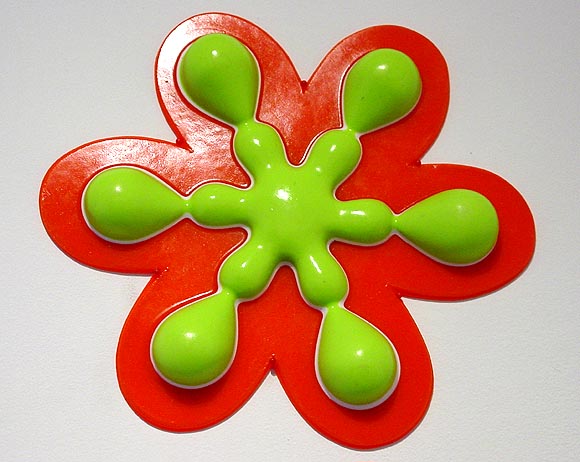
John Monti, Lil Rosette, urethane rubber, also from the Momenta benefit exhibition.
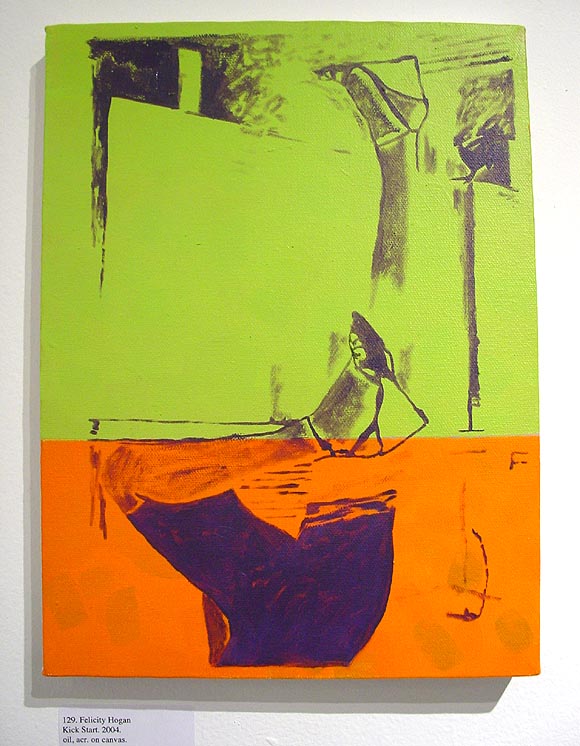
Felicity Hogan, Kick Start, oil, acrylic on canvas.
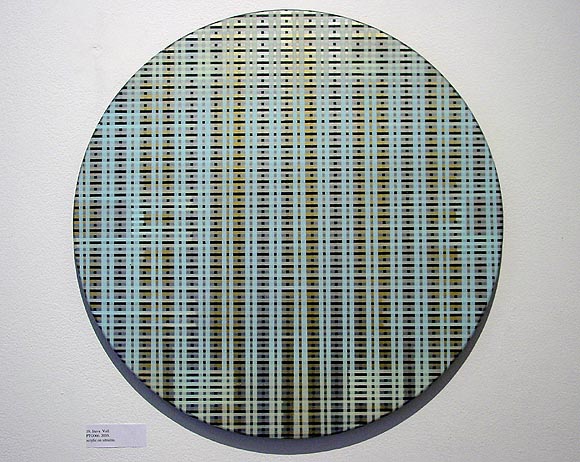
Steve Voll, PTG066, acrylic on Ultra-Lite.
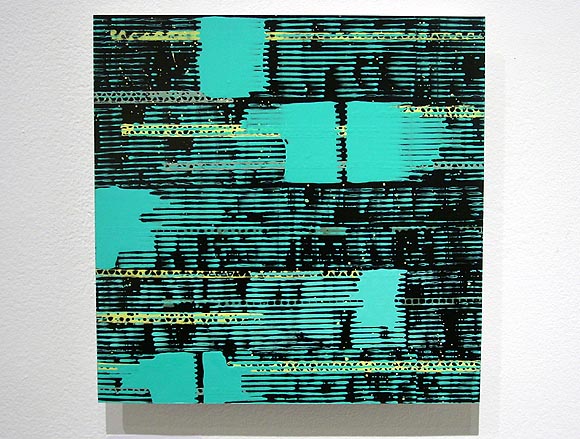
Annette Cords, Zoned #90, acrylic on board. All of the above photos were taken at the opening of the annual Momenta Art benefit, where I also have a piece. The work will be raffled at White Columns on April 30.
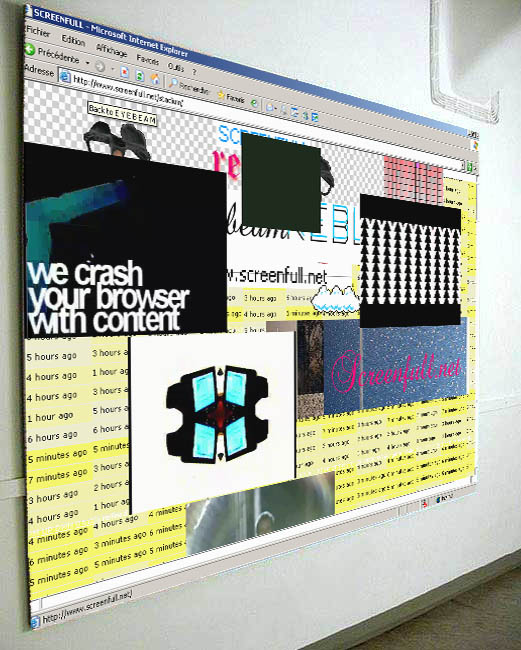
The images I posted earlier of wallpaper paintings evoking HTML frames have gotten the SCREENFULL treatment. Just in case your life wasn't "meta" enough.
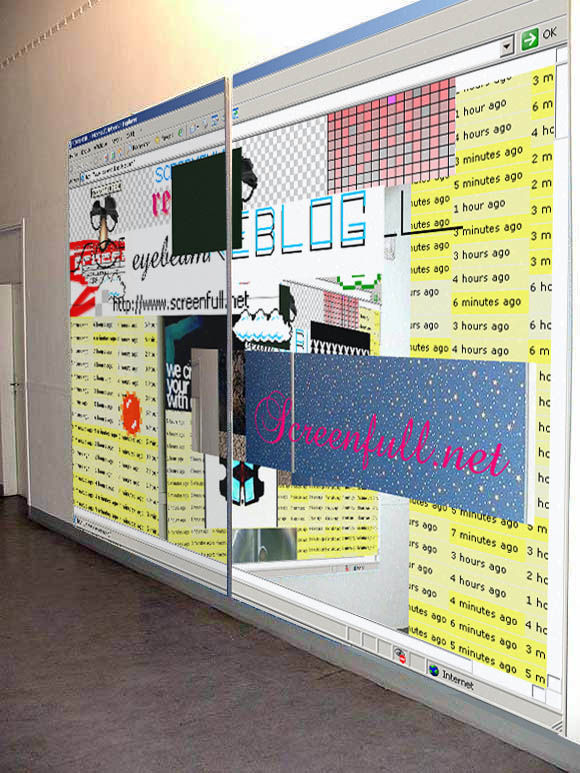
"Calypsum 2" (formerly "Theme from PLUTE") [6.1 MB .mp3]
The volume level is a tad lower than other pieces: I discovered I was recording them too loud and they were clipping at high volume. This is my first work using "continuous controllers"--the filter sweeps aren't actually live. Why tire your hand turning knobs when you can draw a controller curve and let the machine do the work?
After putting up a "plute"-related graphic and adding a back story I changed the name of this piece. It sounds too dreamy and smeary to me to have such an obnoxious word in the title. "Ploot" is supposedly what atomic industry workers call plutonium; I was spelling it differently and may use it again, just not in this piece.
HTML Frame Paintings, etc.
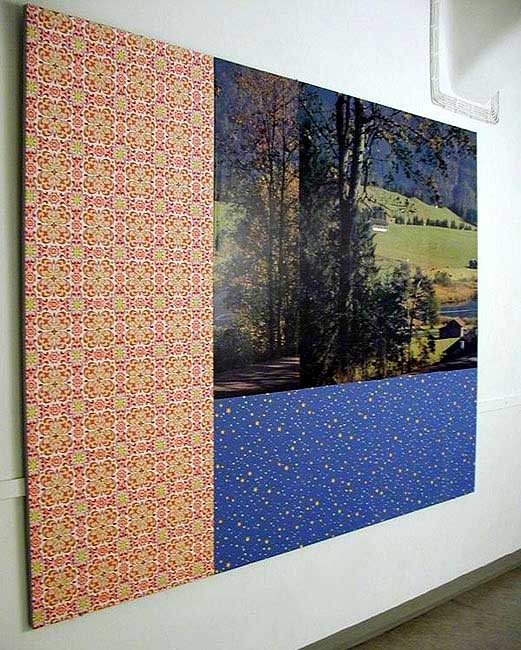
From Olia Lialina's A Vernacular Web: The Indigenous and the Barbarians: "In 2003 the students of the Merz Akademie celebrated the First Ten Years of the WWW by creating an exhibition of objects that symbolized the landmarks of the web's history. The tribute to wallpapers consisted of a huge board of real wallpaper, (from OBI), arranged in a frame style layout. Even in this simple construction it was clearly the skeleton of a web page."
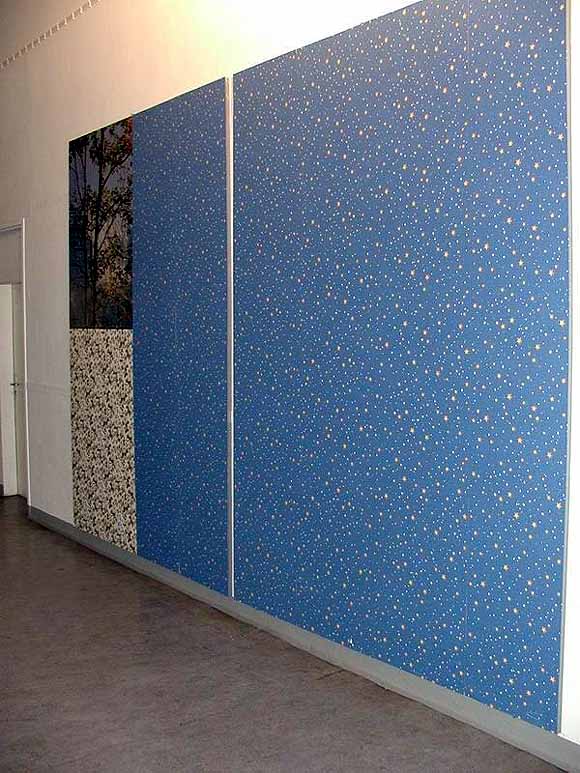
Lialina's article, which is highly recommended reading, covers many elements of early, DIY web design, such as "under construction" pages, homemade buttons, and collections of backgrounds, always in the context of how they've been replaced in a second wave of web practice, dominated by blogs and search engines. Here is a particularly funny comment on MIDI:
As all the instruments were standardized in 1983 the sound effectively goes no further than Italo Disco. There will never be any new and exciting sounds, only updated versions of old sounds. New sounds would only break the compatibility with all the existing MIDI files. Software vendors can't change the "trumpet" to a "Neptune's kinda honkashizzle" because, on the web, you can find all kinds of MIDI files that use the trumpet in many different ways. In this case the only solution is the lowest common denominator. The trumpet sound must fit into James Brown's "Sex Machine" in the same way it fits into "Ride of the Valkyries" by Richard Wagner. It does this by not really fitting into either. At least that's equality.[via]
The result is that most of the time MIDI files give the impression of somebody playing hit music on an electronic organ in the privacy of their own home. In reality this happens at village weddings or the annual gathering of a rabbit breeder's association.

From Brian Turner's posts at WFMU's Beware of the Blog (originally from Stay Free! Daily). His caption is "McMother." Stay Free! says it's a real European McD0nald's ad and not a parody and I guess I believe it but yeesh.
Recipes
Lately I've been cable-surfing the Food Network and digging its sundry cooking "how-to" shows, especially the Japanese version of Iron Chef. [insert long-winded exegesis of show.] Technologically based arts need their equivalent; in fact visual artists lag behind chefs in the eclectic "mixing it up" aesthetic of current haute food prep. Musicians fare somewhat better in this regard because music software and gear matured sooner than imaging software and gear (i.e., it's been "there" longer to jack with), but both music and art improve when practitioners think outside the (software) box, that is, think like Iron Chef Sakai. I'm not saying I do this all the time, but certainly my instincts are to mix media and in the spirit of the food shows, I offer the following recipes for a recent animation (top) and musical effort (bottom). Eventually I'll write a Dogma-like manifesto that codifies these practices as the only right way to make art, but right now I'm still exploring and I haven't reached the really pedantic stage yet.
Example 1
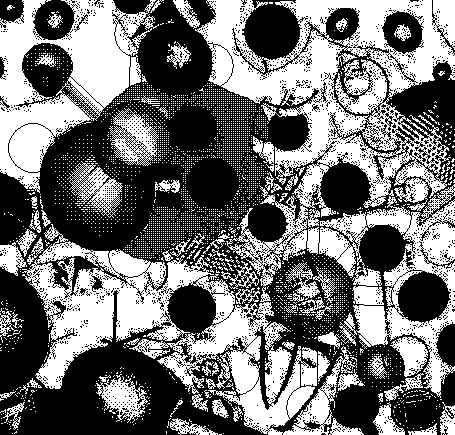
"Abstraction with Two Centrifuges" (2004), animated GIF
Drawings in MSPaintbrush are printed out at different sizes (100% to 600%), cut up with (real) scissors, taped back together in a scrambled collage.Example 2
That piece is finished. The GIF above is a spinoff work, no pun intended.
Collage is photographed with digital camera, detail is cropped and enlarged in Photoshop, converted to greyscale, run through the threshold filter.
In MSPaint, photoshopped image is converted to black and white fill patterns under "image attributes." (MSPaintbrush won't do this without destroying the original image). New fill patterns and the "centrifuge molecules" are added in MSPaintbrush. Saved 8 times, each save becomes a frame, with a different stage of the spinning molecules.
Frames are animated in a GIF building program. Uploaded to web, border is added in html.
"One to Thirty" [6.8 MB .mp3]. The following discussion is pretty brand-intensive, and I apologize for that, but one point I guess I'm trying to convey is that no one piece of software or hardware "makes" the piece; it's mostly in the process.
A factory-programmed tune from the Korg Electribe Amkii (B04 "Techno 12") is slowed down from 125 to 99 bpm. Audio is run through a standard hardware mixing board at low volume. The MIDI out is played by another synth, the Sidstation (a factory preset patch called P73 "Pyramid"), also plugged into the board.The common point of both works is using a combination of programs, effects, changes in resolution, etc. to build up some kind of credible texture. The overall goal is to give sound and image creative integrity beyond their source programming. These recipes are mostly technical. There are content issues arising at various stages of the process, verbalized internally but ultimately best left for the individual to articulate (or not).
The Sid basically only reads one sustained note and some noise, everything else is filtered out.
That note plays over and over as pattern B04 cycles, and is bent in real time with a variety of knobs: (i) the Sid's continuous controllers, changing the cutoff filter and pitch, and (ii) the dials on an analog filter called the Mutator (see below).
All of the above sounds are recorded into the computer through the mixer. But first, the board sends and returns audio from both synths to the Mutator, which uses some sophisticated envelope controls to twist and interweave the two instruments in real time.
An audio part is recorded using an analog to digital recorder (I forget which): about a 7-minute .wav file of the knob-twiddling performance. The file is then edited down to 4.5 minutes in a .wav editor called GoldWave: redundant and/or out-of-tune parts are snipped out.
The .wav file is imported into Cubase, a sequencer program. The tempo track is set at 99 bpm.
The drum riff is a sample that ships with Beatburner, a (virtual) rhythm module plugged into Cubase. Several were tried before I arrived at this one--I may have added some effects processing to it, but probably not. I also tried a MIDI drum part playing various samples. Beatburner plays this drum and bass riff at 99 bpm and it's a decent fit with the existing audio.
Content-wise, what I had in mind was a contradiction between the one, bent note, which is sort of airy Steve Reich minimalism, and the "slammin'" forward movement of that dancefloor beat. No dropouts, crescendos or other dancefloor tricks were used. The piece is still pretty energetic, and might pass for drum and bass, although most of these dance tropes are pretty cliche at this point. [skip long-winded exegesis]
